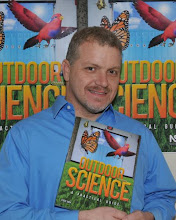Theoretical perspective of proposed research on outdoor science
The theory that I will use is cognitive
constructivism. Piaget’s cognitive
development theory launched the constructivist approach and fits well with many
of the articles and studies that were found in a review of related literature.
As the pilot study begins, students
take pre-tests on both content and attitude regarding learning science
outdoors. Following the pre-tests, students leave the regular, indoor classroom
to venture to the schoolyard for a science lesson on an environmental standard.
Cognitive constructivism has the potential to reveal students’ learning in ways
possibly not nurtured indoors. The will be immersed in the ecosystem that they
are learning about. The study will rely greatly on the views of the
participants, hence the attitude survey (Creswell, 2014). When the
constructivist theory is applied to this research, it is an interconnected hypothesis (Creswell, 2014). The research will
be looking for ways in which the attitude toward learning outdoors influences
student achievement on an environmental standard in elementary schools. With an interconnected hypothesis, ample
opportunity to follow up with additional research may present itself. For instance,
how might achievement alone be affected by teaching science outdoors? This has
been attempted once before, but no evidence of replicating the study has been
found (Cronin-Jones,
L. 2000).
The researcher
plans for the pilot a smaller study that involves fewer students, but maintains
the same essence as the proposal to carry out the full research project later.
The pilot may shed light on how the constructivist theory applies in this
situation. Will students make sense of the outdoor science lesson differently
than they would if it were taught indoors? How will the setting affect them?
When considering engagement in outdoor learning, an important theoretical
question might be whether students are more likely to construct their own
meaning when immersed in the setting that contains the object of study. For
example, if a student is studying how butterflies react to trees or other plants, is it better to be among
living specimens as opposed to in an indoor classroom? That is the premise of
some works that have been published (Rich, 2010). Though the advent of the five
E’s came long after Piaget’s work on cognitive constructivism, the “engage”
step of this model would suggest that perhaps the immersion in the natural
environment would have some bearing on the students’ learning (Chitman-Booker, L., Kopp, K. 2013).
What remains to
be seen is the true interconnectedness of the hypotheses in this pilot and the
eventual study. If attitude and achievement can be linked, there would be room
for future study in that direction. Even if there is no link shown in the
results, follow up to this study could result in contributions to the field of
science education and particularly environmental education.
Bibliography
Chitman-Booker, L., Kopp, K. (2013). The 5 E’s of inquiry-based science.
Huntington Beach, CA. Shell Education.
Creswell, J., (2014). Research design: qualitative, quantitative, and mixed methods
approaches. Thousand Oaks, CA. Sage Publications, Inc.
Cronin-Jones, L. (2000).
The effectiveness of schoolyards as sites for elementary science
instruction. School Science &
Mathematics, 100,
203-212.
Rich, S. (2012). Bringing outdoor science in: thrifty classroom lessons. Washington,
D.C. NSTA Press.
Rich, S. (2010). Outdoor science: a practical
guide. Washington, D.C. NSTA Press.




